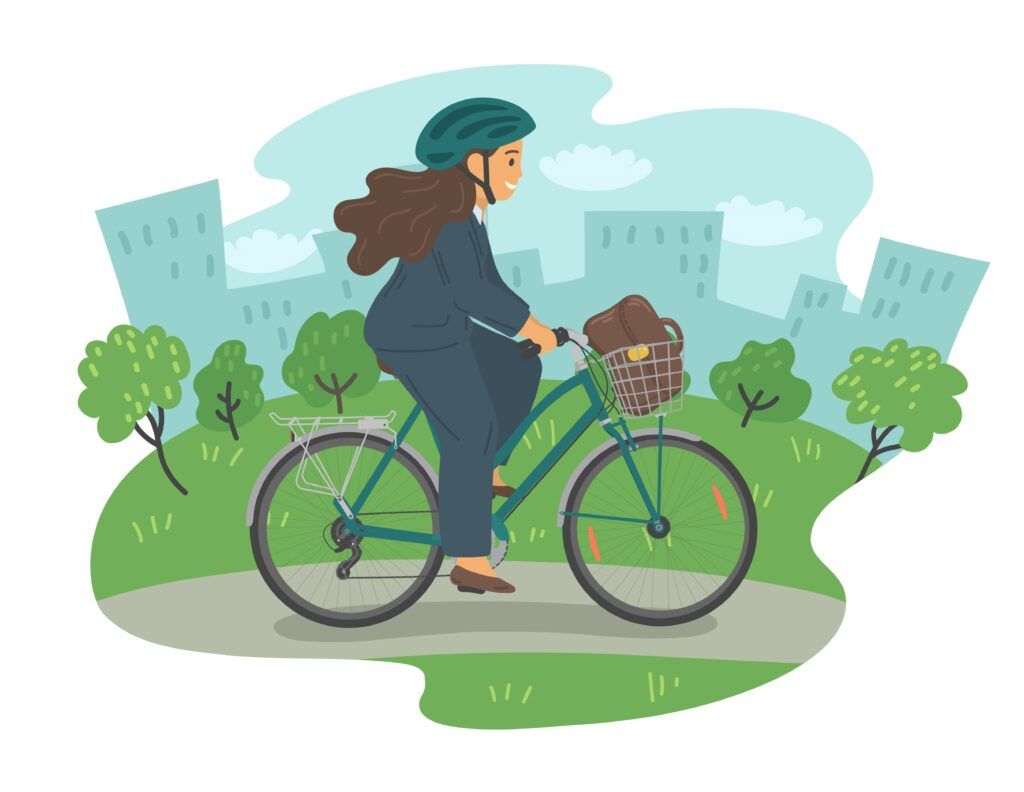Biking to Work – Why Do It?
May 12, 2023 in Wellness, Wonders of the Workplace
By Justin Fuhrmann
Why Should You Bike, Walk, or Scooter to Work?
Over the past three years, many people experienced what life without a commute looked and felt like at some time. While this newfound flexibility has persisted for some, many working Americans now find themselves commuting, at least a few times a week, to offices and meetings. There is evidence that having a commute is beneficial. Commuting provides structure in our daily behaviors, a transitional period between work and home, a shared experience with others, and a space to reflect on the purpose of our work and to mentally check our preparation for the day.
If most of us are going to spend time commuting, how can we make the most of it? For many, minimizing the time we spend commuting is the default goal, so commuting by a personal motor vehicle is assumed to be the preferred method to travel between home and work. This is especially true in the United States and Canada. Yet, commuting via biking, walking, or using other micromobility options has numerous benefits. A more obvious health benefit is that it helps people stay in better shape. A study in the United Kingdom found that men and women who commute by active modes, or public transportation, have significantly lower body mass index and percentage of body fat compared to their counterparts who used a personal motor vehicle. A U.S.-based study found that driving more than 10 miles to and from work is associated with higher blood pressure and higher cholesterol.

Beyond health reasons, there are environmental reasons to consider commuting outside of a personal vehicle. In the United States, 75% of all carbon monoxide pollution comes from motor vehicles. Transportation accounts for the largest portion of the total U.S. Greenhouse Gas Emissions at 27%. Light duty vehicles account for 57% of those emissions with medium and heavy trucks at another 26% (combining to account for 83% of the transportation emissions). By comparison, planes produce 8% of the transportation emissions and rail produces 2%. While the growing adoption of electric vehicles will offset some of these emissions, this innovation alone is not enough to result in the United States reaching net-zero emissions by 2050.
What To Do When Driving Is Your Only Option
In some cases, commuting by car may be the only viable option since many American neighborhoods are not designed in a way that makes other commute options accessible (e.g., mass transit, bike lanes or bike-friendly roads). However you choose to commute to work, to complete errands, or to get around, I recommend considering advocating for more inclusive infrastructure in your community. Inclusive infrastructure is the idea that if roads and trails are designed to be safer for all users and ages, it benefits everyone. Personal motor vehicle drivers benefit because they have less traffic to contend with (because fewer people will need to drive everywhere if they feel safe to use the roads without a personal motor vehicle) and clearer boundaries between different road users and walkers, bikers, public transportation users, and users of other mobility options benefit from safer and more reliable connections between their home and their community. Utilizing inclusive infrastructure effectively is why the famously bike-friendly Netherlands regularly ranks first in the world in car driver satisfaction. Safety is a concern for all road users; it’s estimated 42,915 people were killed in motor vehicle crashes during 2021 in the United States alone. On average, 117 people are killed every day on America’s roads.
My Personal Commuting Story
In addition to the health and environmental reasons that favor a commute by walking, biking, or scootering, you may be surprised by how differently you interact with your own neighborhood and neighbors you pass on your commute when you choose an alternative to driving. I have met more of my neighbors since I personally started to commute to work by bike, and I have found parks, restaurants, and pathways that I didn’t know existed until I stepped out of my car and experienced my commute from an entirely new perspective. I even went so far as to purchase a cargo bike so I can pick up my three daughters from school on a bike and we can get outside and experience more of our area without the need for a personal motor vehicle. It has been a positive change for all of us. Talking or waving to others on my commute, or as I complete errands, may seem like a minor thing, but it is these small human interactions that give us a better sense of community and may even help to build our own network and relationships.
Are you considering making a change to your own commuting habits? Are you already commuting to work without a personal motor vehicle? Are you interested in using your car less frequently or spending more time outdoors? It’s not always sunny and 70 degrees outside, but that doesn’t mean you have to hop in your car! Next week, in anticipation of the DC area’s Bike To Work Day on May 19, 2023, I will share in another blog some of the tips and tricks I have learned during the past year as I have biked to work through every season, and most types of weather. Share your thoughts about commuting to work and what habits you have found to be helpful with us on LinkedIn!

Justin Fuhrmann joined FMP in April 2015 and works with the National Geospatial-Intelligence Agency on policy analysis and formulation, employee benefits, benchmarking and interviewing. Justin is from Bergen County, NJ and now lives in Arlington, VA with his wife and three daughters. Outside of work you can find him skiing, hiking, or exploring the DC monuments.